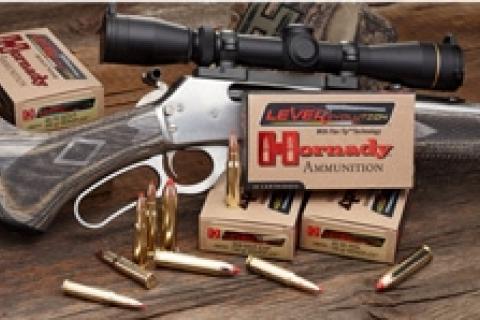
 Perhaps, no cartridge in history has accounted for as many deer as the grand old man of deer cartridges, the 30-30. Introduced in 1895, it was originally deemed the 30 WCF, and first chambered for Winchester's new lever-action rifle, the 1894 Winchester. When Marlin began producing the cartridge, they attached the "-30" to designate 30 grains of the new "smokeless" powder rather than using the Winchester name on their guns. The moniker "30-30" stuck and today, it is still one of the most popular cartridges used by deer hunters throughout the United States.
Perhaps, no cartridge in history has accounted for as many deer as the grand old man of deer cartridges, the 30-30. Introduced in 1895, it was originally deemed the 30 WCF, and first chambered for Winchester's new lever-action rifle, the 1894 Winchester. When Marlin began producing the cartridge, they attached the "-30" to designate 30 grains of the new "smokeless" powder rather than using the Winchester name on their guns. The moniker "30-30" stuck and today, it is still one of the most popular cartridges used by deer hunters throughout the United States.
Rimmed Cases & Round Nose Bullets
The 30-30, like other cartridges of that period, headspaces off the rim of the cartridge. Whereas, cartridges like the 30-06 headspaces off the shoulder. This rim while effective on most lever action and single shot rifles creates somewhat of a problem on bolt action, semi-automatics and most pump-action rifles. The extractor is not able to jump or grasp the rim of the cartridge due to its large diameter.
The rim on the 30-30 also prevents rounds from passing one another without interference causing feeding problems. There are some exceptions: the Remington 788, Savage 340 and Winchester Model 54 come to mind. These bolt guns combated the feeding problem by using a spacer to allow the rounds to be loaded in a slanted manner inside of the magazine.
Most 30-30's use a tubular magazine. The cartridges are loaded into the magazine end for end; the bullet tip rests against the rim of the previous shell. Because of this arrangement, 30-30 shells for the most part are loaded with round nose or flat nose bullets. This school of thought suggests recoil from firing could cause spire point bullets to act like a firing pin — setting off the shell and causing a chain detonation inside of the magazine tube. Backwoods myth or otherwise, I don't want to be the guy to try to prove this theory wrong, so when I use a tubular magazine I use either round nose or flat nose bullets. I've grown quite fond of my eyes and ears.
Hardly Losing its Luster
The 30-30 loaded with a 150 grain bullet carries enough energy to dispatch of deer sized game up to and including black bear up to 200 yards or so, modern cartridges like the 270, 30-06 and 7mm Rem Mag does this with ease, so why hasn't the 30-30 fallen into obscurity, in a word — handloading. RCBS, the company that leads handloading equipment sales, annually compiles a list of their top selling dies used to reload ammunition — the 30-30 has never dropped from the Top 20 list.
Becoming a Pistol Round
As good a rifle round as the 30-30 is, it is a better pistol round, at least in a single shot like the Thompson/Center Contender or the Magnum Research BFR, a revolver, both of which are able to utilize the wide variety of 30 caliber bullets available including the aerodynamic spitzer bullets — wringing out the 30-30's full potential.
Platform for Wildcatters
The 30-30 also spawned an entire generation of wildcats. The now nearly extinct, 22 Hi-Power and the ever-popular 7-30 Waters are just two of the wildcats but dozens of others based off the 30-30 were created for and by shooters. Many of these cartridges were developed to improve the 30-30, but did little to do so.
Raising the Bar
Historically, factory ammunition was limited mainly to 150 grain or 170 grain bullets for the 30-30 because of the round nose or flat nose configurations. However, Remington offered the Accelerator, a 22-caliber bullet surrounded by a 30 caliber plastic sabot, these Accelerators are not designed to be used in a lever gun or any other tubular magazine rifle but Hornady has introduced an offering made specifically for lever action rifles -the LEVERevolution. These cartridges use a rubber- tipped spitzer bullet, which is safe for use in all lever guns. By slightly increasing the velocity and by using a flatter shooting, aerodynamic bullet the 30-30 becomes a 300-yard deer gun.
Rethinking the 30-30
Many who scoff the 30-30 may want to rethink this cartridge. Using today's technology, Hornady's LEVERevolution offerings, the 30-30 retains nearly 1000 ft. lbs. of energy at 300 yards -this isn't your grandpa's 30-30. Sighted 3 inches high at 100 yards, the bullet drop is just 12 inches low at 300 yards. A Marlin 336 or '94 Winchester equipped with a low-powered scout scope or conventionally mounted scope is the perfect prescription for heavy brush hunting or watching an open field. The 30-30 has been given a boost and once again has become a contender as a legitimate deer rifle.
Combine this with the fast handling of a lever action rifle, quick follow up shots at the flick of a wrist, this may be the only rifle a hunter will ever need, but don't tell my wife.
- 9335 views

